
project presentation (pdf file)
Deciphering the mechanistic details of the regulation of the deubiquitinating enzyme AMSH by the STAM protein by a computational and NMR approach. Dr. Olivier WALKER Institut des Sciences Analytiques INTERACT group 5 rue de la Doua 69100 Villeurbanne – France Tel: +33.4.37.42.35.45 e-mail: olivier.walker@univ-lyon1.fr web-site: http://olivier-walker.univ-lyon1.fr Ubiquitination is a core biological process, which signals many cellular events and seals the fate of many proteins. This process is achieved by the covalent attachment of the C-terminal Gly76 of ubiquitin (Ub), a small 76 amino-acid protein, to a lysine residue of a target protein. Proteins can be modified by the attachment of Ub on one (monoubiquitination) or several lysines (multi-monoubiquitination), as well as by the attachment of polyubiquitin chains (polyUb). Although, monoubiquitination is involved in the endocytic process in yeast and mammalian cells, recent advances in the field suggest that multi-monoubiquitination or K63-linked polyubiquitination are playing a major role in the multivesicular body (MVB) pathway. The machinery responsible for committing ubiquitinated cargoes for lysosomal degradation is known as the ESCRT system. Recognition of ubiquitinated cargoes is achieved by modular motifs called Ubiquitin Binding Domains (UBDs), which have been found to function cooperatively. While the STAM protein has been found to recognize K63-linked polyubiquitin, the deubiquitinating enzyme AMSH is responsible for the removal of ubiquitin from its substrate. The detailed mechanistic events that rule the interaction between STAM, AMSH and K63 linked polyubiquitin has not been elucidated yet. A B (A) Structure of the STAMVHS/Ubiquitin complex deposited to the PDB under PDB code 2L0T. (B) Model of the STAMVHS-UIM/di-ubiquitin interaction obtained from NMR constraints. The current PhD position foresees the interaction study of the VHS-UIM-SH3 domain of STAM2 with polyubiquitin chains and AMSH to understand the potential role of STAM in the catalytic regulation of AMSH. This question will be addressed by means of NMR, complemented by computational techniques and more particularly molecular dynamics and accelerated methods. The successful candidate will integrate a young and motivated group located in a brand new institute (opened in November 2011, see http://nmrbiolchem.univ-‐lyon1.fr). She/He will benefit from a high field NMR (600MHz) spectrometer, several GPU based computers dedicated to structure calculations, quantum chemistry and molecular dynamics as well as an outstanding environment comprising several high field NMR spectrometers located in Grenoble and Lyon. Moreover, the lab is fully equipped with devices dedicated to the production of isotope labeled proteins. The duration of this PhD position is 3 years and will be founded by the French Research Ministry. Requirements are as follow: the candidate should have completed (or in stage of completion) M.Sc. degree either in biochemistry, structural biology, physical chemistry, computational science or related fields. Willingness to learn NMR and complementary techniques will be strongly appreciated. References: Fushman, D., and Walker, O. Exploring the linkage dependence of polyubiquitin conformations using molecular modeling J Mol Biol 395, 803-‐814, 2010 Lange, A., Hoeller, D., Wienk, H., Marcillat, O., Lancelin, J. M., and Walker, O. NMR Reveals a Different Mode of Binding of the Stam2 VHS Domain to Ubiquitin and Diubiquitin Biochemistry 50, 48-‐62, 2010 A. Lange, C. Castañeda, D. Hoeller, J-‐M. Lancelin, D. Fushman, O. Walker Evidence for Cooperative and Domain-‐specific Binding of the Signal Transducing Adaptor Molecule 2 (STAM2) to Lys63-‐linked Diubiquitin J. Biol. Chem, 287(22), 18687, 2012 A. Lange, M-‐B. Ismail, G. Riviere, M. Hologne, D. Lacabanne, F. Guillière, J-‐M. Lancelin, I. Krimm, O. Walker Competitive binding of UBPY and ubiquitin to the STAM2 SH3 domain revealed by NMR FEBS. Lett, 586 (19), 3379, 2012
© Copyright 2025











